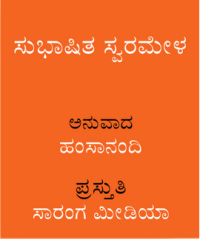Today, 10/1/2014, is the eighth day of Navaratri. This is celebrated in the name of Durga, and so the festival is called Durgashtami. While the Bengal region is known for it’s Durga puja, in Karnataka Navaratri is celebrated in the name of different forms of the Goddess.
In the first seven days of the festival, I wrote some some interesting bits about seven composers of Karnataka Sangeeta and their compositions – Syama Sastry (Devi brova samayamide) , Muttuswamy Dikshita (Meenakshi memudam dehi) ,Tyagaraja (Darini telusukonti) , Swathi Tirunal (Pahi jagajjanani), Muttaiah Bhagavatar (Sudhamayi sudhanidhi) , Lalgudi G Jayaraman (Tillana in Mand) and G N Balasubramanian (Ranjani niranjani).
Today also, I am planning to do the same – although there is meager information on the composer. I chose this song because of couple of different reasons, but let me do some history talking first.
The term used for “composer” in Indian music is Vaggeyakara – which implies that both the words and the music were created by the same person. Traditionally, Indian music was primarily to be performed vocally, and hence the necessity of having words. Therefore, unlike in western music, there were almost no compositions which were created for playing on instruments until very recent times.
But there have been instances when the lyrics are penned by one person and the music given by another. We have very limited view of our music compositions before the 16th-17th centuries. It may come as a surprise to a lot of people, but most of compositions of early composers such as Purandara Dasa (and other Haridasas) or Annamayya have been tuned by later day musicians. Only a few have retained their original form. There are also instances where in the lyrics were written by a person specifically to be given a musical form by another. I can cite the example of Devottama Jois writing the sahitya for the 108 compositions on Chamundeswari for Muttaiah Bhagavatar during his stint in Mysore as the Asthana Vidwan. Then there are cases of Swati Tirunal‘s compositions being re-fitted with music by Muttaiah Bhagavatar, and later by Semmangudi Srinivasa Iyer. So in such cases, the role of Vaggeyakara is split between two people.
And then in some cases, compositions that were probably never set to music or sung before, are set to music by a musician, and they become popular as a “composition” of the person who wrote the sahitya lines, rather than the person who set music. The composition I am talking about is one such , which is set in multiple ragas.
Ragamalika (ರಾಗಮಾಲಿಕಾ, ರಾಗಮಾಲಿಕೆ) – is a type of composition that is quite popular in South Indian classical music today. As the name suggests, such a composition sung in multiple ragas, and so the name Ragamalika, i.e. “garland of ragas”. As a composition type, they seem to gained popularity from the early 18th century. Muttuswami Dikshita’s father Ramaswamy Dikshita, and his guru Veerabhadrayya are some of the earliest Ragamalika composers known. As I was telling earlier, several Purandara Dasa compositions that are sung as Ragamalikas, have been set to music by later day musicians, since we have lost most of original structure of haridasa compositions from the 15-18th centuries. And their ragamalika form is more than likely to be of recent origin.
There is some food for thought here. Why didn’t Haridasa’s who composed suLAdis , which are compositions in multiple tALas (tALamAlike), think of composing in multiple ragas? They my indeed have, but we can’t prove they did. As an aside I can cite a composition of Sripadaraya ( who composed several decades before Purandara dasa) – ಲಾಲಿ ಗೋವಿಂದ ಲಾಲಿ – in which three of the twenty three charaNas have names of the ragas embedded in the lyrics (Kalyani, Anandabhairavi and Devagandhara) giving us an opportunity to speculate that the composition indeed might have been a ragamalike, sung in those ragas for those specific charaNas ( because that’s how the raga signature is included in more recent ragamalika compositions). Yes, again, it remains only a speculation.
Today’s ragamalika, Srichakraraja simhasaneshwari, is said to be a “composition” of Agastyar – only means that someone with a pen name “Agastyar” wrote the sahitya, as the language and style look contemporary. This is set in four ragas, that are sung in madhyama shruti – Jhanjoti, nadanamakriya, Punnagavarali and Sindhubhairavi.
Now listen to a rendition of this composition by Aravind Bhargav, a worthy disciple of the Mandolin maestro Srinivas, who passed away recently. This is from a concert recently in memory of his guru:
The embedded video seems to start at the wrong time – Start from the 1hr 35m mark to listen to Srichakraraja simhasaneshwari in ragamalika. I recommend you listen not only to this composition (which is only about 5 minutes long), but the entire concert, which is excellent.
Happy listening!
-neelanjana




ನಿಮ್ಮ ಟಿಪ್ಪಣಿ ಬರೆಯಿರಿ
Comments feed for this article